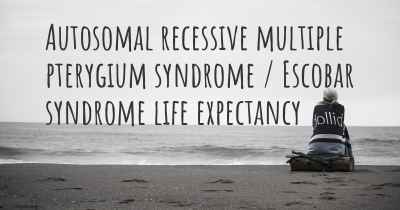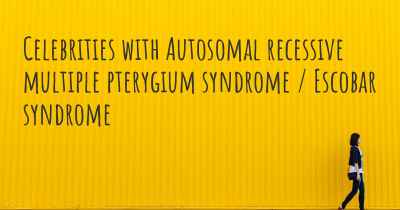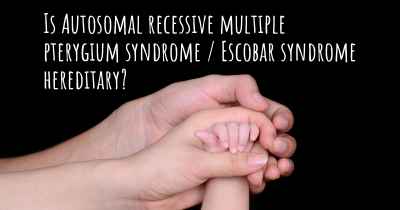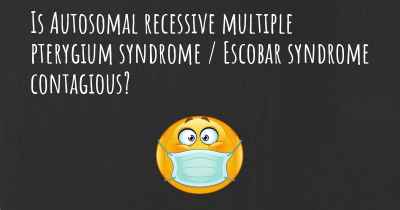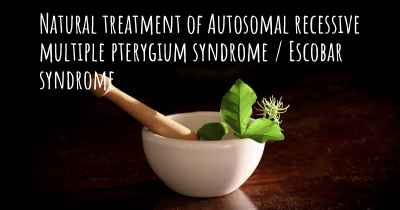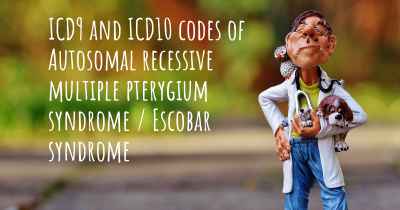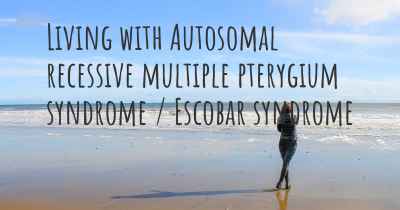Which are the symptoms of Autosomal recessive multiple pterygium syndrome / Escobar syndrome?
See the worst symptoms of affected by Autosomal recessive multiple pterygium syndrome / Escobar syndrome here
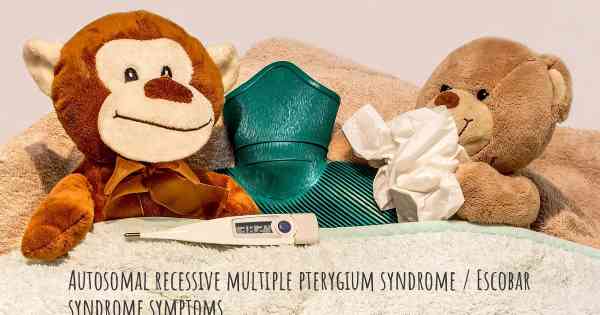
Symptoms of Autosomal Recessive Multiple Pterygium Syndrome / Escobar Syndrome
Autosomal recessive multiple pterygium syndrome, also known as Escobar syndrome, is a rare genetic disorder that primarily affects the musculoskeletal system. It is characterized by multiple joint contractures (pterygia), webbing of the skin (pterygium), and other associated abnormalities. The severity and specific symptoms can vary among affected individuals, but there are several key features commonly observed in this syndrome.
Joint Contractures
Joint contractures are a hallmark feature of Autosomal recessive multiple pterygium syndrome. These contractures involve the abnormal shortening and tightening of muscles, tendons, and ligaments around the joints, leading to limited range of motion and stiffness. The joints most commonly affected include the elbows, knees, hips, and fingers. The severity of contractures can vary, ranging from mild limitations to severe deformities that significantly impact mobility.
Pterygium
Pterygium refers to the presence of webbing or excess skin between body parts. In Autosomal recessive multiple pterygium syndrome, pterygium commonly occurs in the neck, armpits (axillae), and groin area. This excess skin can restrict movement and contribute to the joint contractures observed in affected individuals.
Facial Abnormalities
Individuals with Autosomal recessive multiple pterygium syndrome often exhibit distinctive facial features. These may include a small mouth (microstomia), a short or upturned nose, a small chin (micrognathia), and a cleft palate. These facial abnormalities can contribute to difficulties with feeding, speech, and dental issues.
Clubfoot
Clubfoot, also known as talipes equinovarus, is a common feature of Autosomal recessive multiple pterygium syndrome. It is characterized by the inward and downward twisting of the foot, making it difficult to walk or put weight on the affected foot. Clubfoot can be present at birth or develop shortly after.
Genital Abnormalities
Some individuals with Autosomal recessive multiple pterygium syndrome may have genital abnormalities. In males, these abnormalities can include undescended testes (cryptorchidism) or the opening of the urethra on the underside of the penis (hypospadias). In females, abnormalities may involve the uterus or vaginal malformations.
Other Associated Features
There are several other associated features that can be present in Autosomal recessive multiple pterygium syndrome. These may include:
- Respiratory difficulties: Some individuals may experience breathing problems due to the abnormal positioning of the ribs or a small chest cavity.
- Scoliosis: Abnormal curvature of the spine (scoliosis) can occur in some cases, leading to postural abnormalities and potential respiratory issues.
- Intellectual disability: While not always present, some individuals with Autosomal recessive multiple pterygium syndrome may have intellectual disability or developmental delays.
- Cardiac abnormalities: Certain heart defects, such as ventricular septal defects or patent ductus arteriosus, have been reported in a small number of cases.
- Eye abnormalities: Some individuals may have abnormalities of the eyes, including ptosis (drooping eyelids), strabismus (crossed eyes), or other vision problems.
It is important to note that the severity and combination of symptoms can vary widely among individuals with Autosomal recessive multiple pterygium syndrome. Some individuals may have mild manifestations, while others may experience more severe complications that require medical intervention and ongoing care.
Diagnosis of Autosomal recessive multiple pterygium syndrome is typically based on clinical evaluation, identification of characteristic physical features, and genetic testing. Genetic counseling is recommended for affected individuals and their families to understand the inheritance pattern and potential risks for future pregnancies.
While there is no cure for Autosomal recessive multiple pterygium syndrome, management focuses on addressing the specific symptoms and complications. This may involve a multidisciplinary approach, including orthopedic interventions, physical therapy, speech therapy, and surgical procedures to improve joint mobility, correct deformities, and address associated abnormalities.
In conclusion, Autosomal recessive multiple pterygium syndrome, or Escobar syndrome, is a rare genetic disorder characterized by joint contractures, pterygium, facial abnormalities, clubfoot, genital abnormalities, and other associated features. Early diagnosis, comprehensive medical care, and supportive interventions can help improve the quality of life for individuals affected by this syndrome.
